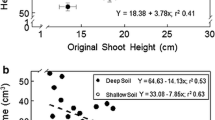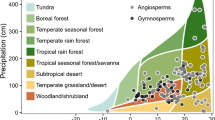Abstract
The value of initial stem diameter near the root collar, shoot length and number of first-order lateral roots (FOLR) as morphological indicators of stock quality and field performance was examined for bareroot (1+0, undercut) red oak (Quercus rubra L.) underplanted in a shelterwood in central Ontario. These three attributes were measured on more than 400 seedlings prior to planting, and their relationship with height and basal diameter growth two years after planting was determined using correlation and regression analysis. Initial diameter, shoot length and number of FOLR were positively and significantly correlated with second-year height and diameter. These relationships were strongest for diameter, but this variable explained less than 25% of the total variation in growth. Of the three indicators, diameter was also the best predictor of several physical characteristics of root systems two years after planting. Initial diameter was significantly correlated with root volume, root area and lateral root, taproot and total root dry mass. Weaker relationships existed between initial shoot length and number of FOLR and second-year root system features. Stem diameter two years after planting was more strongly related to root volume, area and dry mass than was initial diameter, the probable result of adjustment in root-shoot balance of planting stock to the shelterwood environment.
Similar content being viewed by others
References
Bardon, R.E. and Countryman, D.W. 1993. Survival and growth for the first-growing season of northern red oak (Quercus rubraL.) seedlings underplanted in mixed upland hardwood stands in south central Iowa, pp. 195–209. In: Gillespie, A.R., Parker, G.R., Pope, P.E. and Rink, G. (Eds) Proc. 9th Central Hardwood Forest Conf. USDA Forest Serv., North Central Forest Exp. Sta., St. Paul, MN. Gen. Tech. Rep. NC-161.
Dey, D. and Buchanan, M. 1995. Red Oak (Quercus rubraL.) Acorn Collection, Nursery Culture and Direct Seeding: A Literature Review. Ont.Min. Nat. Resour., Ont. Forest Res. Inst., Sault Ste. Marie, Ontario. Forest Res. Info. Pap. No. 122. 46 p.
Dey, D.C. and Parker, W.C. 1997. Overstory density affects field performance of underplanted red oak (Quercus rubraL.) in Ontario. N. J. Appl. For. (in press).
Gordon, A.M. 1988. Graded northern red oak planting stock: dimensions and outplanting performance. Tree Planters' Notes 39(4): 33–35.
Johnson, P.S. 1981. Nursery stock requirements for oak planting in upland forests, pp. 2–19. In: Proc, Northeastern Area Nurserymen's Conf. Missouri Dept. Conserv., Jefferson City, MO.
Johnson, P.S. 1984. Responses of planted northern red oak to three overstory treatments. Can. J. Forest Res. 14: 536–542.
Johnson, P.S. 1992. Underplanting northern red oak in Missouri without herbicides. USDA Forest Serv., North Central Forest Exp. Sta., St. Paul, MN. Gen. Tech. Rep. NC-152.
Johnson, P.S., Novinger, S.L. and Mares, W.G. 1984. Root, shoot and leaf area growth potential of northern red oak planting stock. Forest Sci. 30: 1017–1026.
Kaczmarek, D.J. and Pope, P.E. 1993a. Covariate analysis of northern red oak seedling growth, pp. 351–356. In: Brissette, J.C. (Ed) Proc. 7th Biennial Southern Silvicultural Research Conf. USDA Forest Serv., Southern Forest Exp. Sta., New Orleans, LA. Gen. Tech. Rep. SO-93.
Kaczmarek, D.J. and Pope, P.E. 1993b. Seedling morphology related to growth and survival of northern red oak, p. 11. In: Thompson, J.R., Schultz, R.C. and Van Sambeek, J.W. (Eds) Fifth Workshop on Seedling Physiology and Growth Problems in Oak Plantings. USDA Forest Serv., North Central Forest Exp. Sta., St. Paul, MN. Gen. Tech. Rep. NC-158.
Kormanik, P.P. and Ruehle, J.R. 1989. First-order lateral root development: Something to consider in mother tree and progeny assessment, pp. 220–227. In: Proc. 20th Southern Forest Tree Improvement Conf. Southern Forest Tree Improvement Committee, Charleston, SC. Pub. No. 42.
Kormanik, P.P., Ruehle, J.R. and Muse, H.D. 1988. Frequency distributions of seedlings by first-order lateral roots: A phenotypic or genotypic expression, pp. 181–187. In: Proc. 31st Northeastern Forest Tree Improvement Conf. Penn. St. Univ., University Park, PA.
Kormanik, P.P., Sung, S.J., Kormanik, T.L. and Zarnock, J. 1995. Oak regeneration – why big is better, pp. 117–123. In: Landis, T.D. and Cregg, B. (Eds) Nat. Proc., Forest and Conservation Nursery Associations. USDA Forest Serv., Pacific Northwest Research Sta., Portland, OR. Gen. Tech. Rep. PNW-365.
Pope, P.E. 1993. A historical perspective of planting and seeding oaks: Progress, problems, and status, pp. 224–240. In: Loftis, D.L. and McGee, C.E. (Eds) Proc. Oak Regeneration: Serious Problems, Practical Recommendations. USDA Forest Serv., Southeastern Forest Exp. Sta., Asheville, NC. Gen. Tech. Rep. SE-84.
SAS Institute Inc. 1988a. SAS Procedures Guide, Release 6.03 Edition. SAS Institute Inc., Cary, NC. 441 p.
SAS Institute Inc. 1988b. SAS/STAT User's Guide, Release 6.03 Edition. SAS Institute Inc., Cary, NC. 1,028 p.
Schultz, R.C. and Thompson, J.R. 1990. Nursery cultural practices that improve hardwood seedling root morphology. Tree Planters' Notes 41: 21–32.
Stroempl, G. 1985. Grading northern red oak planting stock. Tree Planters' Notes 36(1): 15–18.
Struve, D.K. 1990. Root regeneration in transplanted deciduous nursery stock. HortSci. 25: 266–270.
Teclaw, R.M. and Isebrands, J.G. 1991. Artificial regeneration of northern red oak in the Lake States, pp. 187–197. In: Laursen, S.B. and Deboe, J.F. (Eds) Proc. Oak Resource in the Upper Midwest: Implications for Management. Univ. Minn., Minn. Ext. Serv., St. Paul, MN. Publ. No. NR-BU-5663-S.
Teclaw, R.M. and Isebrands, J.G. 1993. Artificial regeneration of northern red oak in the Lake States with a light shelterwood: A departure from tradition, pp. 185–194. In: Gillespie, A.R., Parker, G.R., Pope, P.E. and Rink, G. (Eds) Proc. 9th Central Hardwood Forest Conf. USDA Forest Serv., North Central Forest Exp. Sta., St. Paul, MN. Gen. Tech. Rep. NC-161.
Thompson, J.R. and Schultz, R.C. 1995. Root system morphology of Quercus rubraL. planting stock and 3-year field performance in Iowa. New Forests 9: 225–236.
von Althen, F.W. 1990. Hardwood Planting on Abandoned Farmland in Southern Ontario. Forestry Canada, Ontario Region. Great Lakes Forestry Centre, Sault Ste. Marie, Ontario. 77 p.
Wendel, G.W. 1980. Growth and survival of planted northern red oak seedlings in West Virginia. South. J. Appl. For. 4: 49–54.
Zaczek, J.J., Steiner, K.C. and Bowersox, T.W. 1993. Performance of northern red oak planting stock. North. J. Appl. For. 10: 105–111.
Author information
Authors and Affiliations
Rights and permissions
About this article
Cite this article
Dey, D.C., Parker, W.C. Morphological indicators of stock quality and field performance of red oak (Quercus rubra L.) seedlings underplanted in a central Ontario shelterwood. New Forests 14, 145–156 (1997). https://doi.org/10.1023/A:1006577201244
Issue Date:
DOI: https://doi.org/10.1023/A:1006577201244




